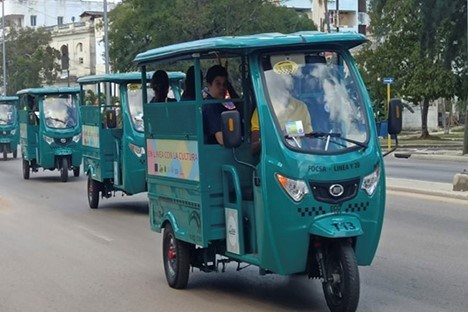Cuban Capital Experiments with Electric Mobility

A total of 106 electric three-wheel taxis active in Havana seek to mitigate urban transport problems from fuel shortages
HAVANA TIMES – As part of a project that is betting on electric mobility in the Cuban capital, which has a great public transport deficit, two new routes for electric three-wheel taxis are now up and running.
With these two new routes – one on Linea Street, in Vedado, and the other one in Central Havana, the most densely populated municipality in Cuba-, the city now has a total of 13 routes and 106 tricycles working.
They can travel between three and five kilometers, on average, along flat roads. Even though this is a limited proposal, some people see it as a relief, while others complain about how it works.
According to Luis Carlos Gongora, director of International Relations and Foreign Trade in Havana’s local government, a sustainable urban mobility plan has been made available to develop the city’s transport system up until 2030, which favors investments in low or zero carbon emission vehicles.
The proposal to combine electric vehicles on short stretches and bicycles seeks to decongest bus transport to some extent, which has 40% less units availability right now, leading to crowds at bus stops and inside buses, accelerating their wear and tear and reducing their lifespan.
Gongora explained to the local press that the electric tricycles – using Chinese technology – were assembled at a factory in Havana. They can run for 120 kilometers and need eight hours to recharge, which can be done during the night.
The Canadian import company Terracan promises a stable supply of parts and pieces, he added.
According to Lauger Medina, from the Provincial Transport Board, the plan is to “progressively open up new routes in every municipality in the city until it reaches 51, three on average for every area, depending on financial resources.”
Tricycles and more culture
There are two reasons for setting up the route on Linea Street, one of Havana’s main streets, even though it is only three kilometers long.
In this regard, Sueidys Alvarez, director of the Corredor Cultural de Linea project pointed out that it was the project’s intention – with support from collaborative efforts with the European Union – to turn Linea into a corredor cultural (cultural corridor) that it is, with different cultural facilities located there.
On this street and in neighboring areas you can find many theaters – Ciervo Encantado, Mella, Trianon, Bertolt Brecht, the Adolfo Llauradó movie theaters, Raquel Revuelta and Ludi Teatro–, the Casa del Alba Cultural, art galleries and the fairground on 18th and Linea Streets, to name a few.
Alvarez said that implementing electric mobility “has always been a dream of” architects, leaders and urban planners, because of the low carbon emissions it produces in the city.
She pointed out that the project’s mission is to support the first trial runs and, in three kilometers, connect people who live in Linea with the people who visit cultural facilities here.
Simple math
Tricycles can carry six people, which means that if they all work properly, 636 people can move around at the same time.
According to drivers of these vehicles, the schedule accounts for eight round trips every day, which represents 16 trips a day to transport over 10,176 clients, as not everyone travels the entire trajectory and other people can hop on.
Although this number is insignificant in a city with 2,1 million inhabitants, tricycles offer another financial option to move around. A trip costs four pesos, in contrast to the 50 pesos for a trip in an almendron (cars from the ‘50s) that travel the city’s main streets.
However, opinions vary about this service.
Women at the wheel
When this transport system kicked off, women drivers were employed and now there are also quite a few men driving them, even though women are given preference.
According to Gongora, women continue to be the preferred option in the selection process, as part of the country’s actions in response to the Women’s Advancement Plan.
Talking about her experience as a driver, Gleisy Maria Desae said that sometimes it’s hard for her to be on time because her schedule coincides with the time she needs to take her children to school, “but I can do it with support from my family.”
On the other hand, she said, “women are underestimated because people think we don’t know how to drive, but then they realize that actually yes we can.”
Julio Cesar Rodriguez is one of the drivers on the Linea route, and he believes that this form of transport “really helps the population, regardless of the fact that more vehicles and routes are needed. Opinions are positive in neighborhoods,” he notes.






A great idea, as long as there is enough electricity available to power them – when they need to be charged,
These appear to be a great way to transport people safely and to save gas. They should be allowed.